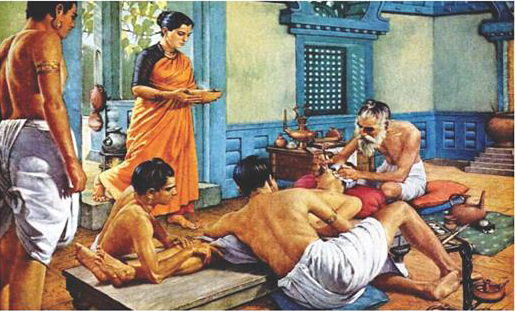
Indian Medicine And Homoeopathy Journal
Journal For Siddha, Ayurveda, Unani, Yoga & Naturopathy and Homoeopathy.

Journal For Siddha, Ayurveda, Unani, Yoga & Naturopathy and Homoeopathy.
Ayurveda is the Ancient System of Medicine of the Indian subcontinent. The word Ayurveda is the conjugation of the words Ayur and Veda wherein Ayur denotes life and Veda denotes Knowledge. Based on above terms the word Ayurveda can be translated as “Science of Life”.
This unique system of medicine aims to prevent disease and maintain positive health and to relieve or cure the disease. Ayurveda gives the exact meaning for the word Arogyam. (A Rogashya Bhavam) which means free from disease and Arogyam thus defined by Ayurveda as

Samadosha SamaAgnicha Samadhatu mala Kriyaha
Prasanna Atmen indhriya Manaha Swastha ityabhidheeyate
- Sushrutha Samhitha
It defines a healthy person as someone whose three doshas (Physiological Elements) are all in equilibrium. The thirteen digestive fires are in a balanced state. The Seven Dhatus / body tissues, body wastes like faecesetc are in equilibrium state and with normal physical function. The quote also states that the Mind (Mana), Five Sense Organs (Indhriya) and True Soul (Atma) must also be in a pleasant state (prassannah). Body (physical activity). Mind (Psychological activity) is binding together. When a person is balanced in all of those are he or she is considered healthy by Ayurveda and it’s giving Emphasis to Regimen for leading healthy long life.
Regimen as follows
| GarbhiniParicharya (Anti Natal care) | SuthikaParicharya (Post Natal Care) | SisuParicharya (Pediatric Care) |
| Dina charya (Daily Routine Regimen) | Rathricharya (Night time regimen) | AharaCharya (Regimen for wholesome diet, Dining Etiquette) |
| ViharaCharya (Regimen for lifestyle activity) | RutuCharya (Regimen for seasonal variation) |
If any improper in above regimen it leads to ill healthy state. Nowadays, in modern era multiple medical specialties departments are available in western system of medicine.
The Ayurveda is pioneer for specialties treatment it’s divided into Eight Branch and it’s coined as Astanga of Ayurveda.
| Kaya Chikitsha (General Medicine) | BalaChikitsha (Pediatric treatment) | GrahaChikitsha (Psychiatric treatment) |
| SalyaTantram (Surgery) | SalakyaTantram (ENT treatments) | Agada Tantra (Toxicology) |
| RasayanaChikitsha (Rejuvenation Therapy) | Vajikaranam (Aphrodisiac treatment) |
The methods of treatment that are employed in Ayurveda are two they are...
Samana Cikitsa
Palliative treatment of the disease, which involves administration of internal and external medicines, recitation of suitable mantras, usage of Ratnasetc to palliate the vitiated Doshas.
Sodhana Cikitsa
Therapies wherein purging out the grossly vitiated doshasfrom the body through various orifices takes place. The Sodhana cikitsa is aneliminative type of treatment. It consists of three stages namely
Poorvakarma
It includes Oleation (usage of medicated oils both internal and external) and Sudation therapy (fomentation with medicated decoctions, powders etc,).
Pradhana / Pancha karma
Includes Vamana, Virechana, Vasthi, Nasyam and Rakthamokshanam.
Therapeutic process wherein excess vitiated doshas are broughtout through the mouth by inducing Emesis.
Procedure wherein using medicine for Purgation is induced expelling excess vitiated doshas in the form ofcatharsis.
Treatment that makes use of oil and kashayam as enema toremedy.
Treatment where medicated oils or powders are administeredas inhalations.
Bloodletting where vitiated doshas are drawn outby bloodletting with the help of Leeches or through Venesection.
Paschat Karma
Includes food and dietetic regimen and activities which normalize the digestive fire which gets depleted after Pradhana Karma.